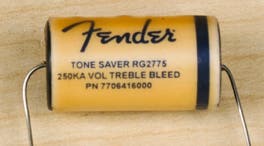






Single Coil
Humbucker
250 kOhm 65,- Euros in stock!
500 kOhm 72,- Euros in stock!
If you experience tonal change when turning down the volume control on your guitar, the Fender Tone Saver is a great solution. Unlike traditional treble bleed circuits that involve connecting tiny parts together with delicate soldering, the Tone Saver contains a special R/C network inside one convenient enclosure that will keep your guitar’s tone remarkably consistent at any setting. Just solder the leads to the center and outside lugs of your guitar’s volume control and you’re done. Available for 250k and 500k audio guitar volume controls.


There are a lot of different opinions about the use of a ‘treble-bleed’ on the volume control of an electric guitar. We at ProGuitar are of the opinion that this is an absolute must have, especially when a single channel amp is used without a bright cap at input of amp.
The reason why opinions differ on this subject is caused by the fact, that for instance many ’old‘ and only very few ’new‘ amplifiers have a ’bright-cap‘ installed at the input which has a similar function as the treble-bleed at the volume control of the guitar.
Many customers however, when adjusting through their guitar volume control very often considered this tone to be too thin and that is why amplifier manufacturers stopped mounting them over the past decades.
Another reason of course is that the latest volume controls (for instance those from CTS) are produced on printed circuit boards (with a thin, evaporated circuit path) thus creating a capacity that loses highs when adjusted. On top of that, each guitar player has his own ideas about what the sound should be like when roll the volume control downwards.
The simplest solution would be to solder a capacitor parallel over the two available connectors of the volume control. When adjusting down, the highs remain present but not the lows. (Similar to a bright-cap in the amplifier.)
After that one can solder a suitable resistor parallel to the pots of the volume control to make sure the lows remain present as well – the value of which of course depends upon the features of the pickups and the amp.
However, in the ears of many customers this was not original enough compared to the sound produced by the old controls on old guitars. Larry Craig (Neil Young’s guitar technician) told me years ago: ‘Ron, don’t do it parallel, do it serial!’ That means to solder the capacitor AND the resistor not in a parallel, but in a serial connection. Much to my surprise, adjusting the volume control made the guitar sound much more organic and authentic but still not effective like parallel wiring.
Especially for this purpose, Fender developed the Tone Saver (being pretty expensive). But a couple of self appointed technicians claimed that the same effect can be achieved by using separate components that would cost just a few Cents.
Therefore ProGuitar has tackled this issue. In the laboratory and together with our engineer Sigi Bombik we researched the electronic inner workings of the Fender Tone Saver. Doing so, we ran into some surprises. Rapidly we found out, that we are not just dealing with a condenser and a resistor in serially; the Tone Saver is much more complex
The Fender Tone Saver for 250k pots is a 130kOhm Carbon Composition Resistor serial with a 1000pF Styroflex Capacitor
The Fender Tone Saver for 500k pots is a 240kOhm Carbon Composition Resistor serial with a 500pF Styroflex Capacitor
The Styroflex cap makes the difference in tone - the trebles are much more organic than fro other capacitors.

